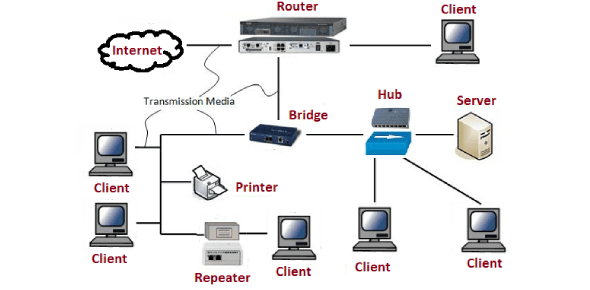Hybridnetworkyt.com – The definition of a computer network is two or more computer devices that are interconnected or connected to each other and are used for various data sources.
Each endpoint in a network has an identifier, which is usually called an IP address or media access control address.
Endpoints can include servers, computers, telephones, and other network hardware. Computer networks (jarkom) can be created using a combination of cable and wireless technology.
Networks can be private or public, when using a private network, it usually requires user access to enter credentials in the form of a password which is entered manually by the administrator or obtained directly by the user. For use of public networks such as the internet, access is not limited.
The following are various definitions of computer networks.
What is meant by a computer network?

Take a look at the following questions about understanding computer networks.
A computer network is a network that is connected electronically between computers to communicate with each other by exchanging data and sharing resources with each other.
The goal of a computer network is so that each part of the computer network can request and provide services.
Below, the types and definitions of computer networks.
Types of Computer Networks
1. PAN (Personal Area Network)
The definition of a PAN computer network is a short-range communication network that connects one device to another.
This type of network covers a smaller area, for example offices and homes. Usually, it is widely used only for internet purposes, as well as printers.
And it doesn’t require large resources to use a PAN network.
2. LAN (Local Area Network)
The LAN network functions to connect network devices in relatively small coverage conditions. Lan is a type of computer network that is commonly found.
Examples of implementing LAN networks are network systems in schools, offices or homes.
Many people tend to use certain types of connectivity, especially token ring and ethernet.
Apart from that, LAN also provides wireless network technology using WiFi and is better known as WLAN (Wireless Local Area Network).
3. CAN (Campus Area Network)
The definition of a CAN computer network is a network that connects various devices and computers in an educational institution such as a school, campus, university, and so on.
The CAN network can be said to have similarities to MAN, but is more limited in campus or academic scope.
This network is mostly used for lab practice, email, class updates, and so on.
4. MAN (Metropolitan Area Network)
MAN is a network that connects one computer device with other devices within a city on the same network. This type of network is larger than a LAN network.
5. WAN (Wide Area Network)
WAN is a collection of LANs that are geographically distributed. WAN networks tend to use technologies such as ATM, X.25, and Frame Relay for longer distance connectivity.
6. Internet
The Internet is the largest computer network ever created by humans. The scope of the internet covers almost all corners of the world.
Anyone can access various sources of information on various computer devices, such as PC, smartphone, laptop, tablet, TV, and so on.
7. VPN (Virtual Private Network)
VPN is one solution to provide a safer internet connection. VPN can create a secure path for data transmission needs.
Currently, there are many platforms that sell VPN for free, or provide premium access.
Computer Networks Based on Transmission Type
Based on its fundamental form, computer networks are divided into two types, namely distance and transmission.
Following are two types of classification of computer network types based on transmission.
1. Broadcast
A broadcast network is a single communication channel that is used jointly by several devices connected to the same network.
Packages are small messages sent by one machine to another machine.
The address field contains information about to whom the package will be sent. If the package is addressed to him, it will be processed immediately.
If a packet is sent to another machine, the machine will automatically ignore it.
2. Point-to-Point
The second type is a point-to-point network consisting of several individual pair connections, from one device to another.
To be able to send a packet to the destination address, it is necessary to pass through several intermediary machines.
So, you often have to go through many routes with possibly different distances. Therefore, the route algorithm plays a very important role in this network.
Computer Network Topology
Apart from knowing the types and meaning of computer networks, the next review is about computer network topology.
The definition of computer network topology is a method or method of connecting or connecting one computer to another computer using cables or without cables.
The following are various computer network topologies and their meanings.
1. Bus

Bus topology is a topology that has a single cable to which each workstation and server are connected to each other.
The advantage of the bus topology itself is that when developing new networks and workstations, it does not interfere with other workstations.
The disadvantage is that when the cable is damaged or broken, there will be disruption to the entire network.
2. Ring (ring)
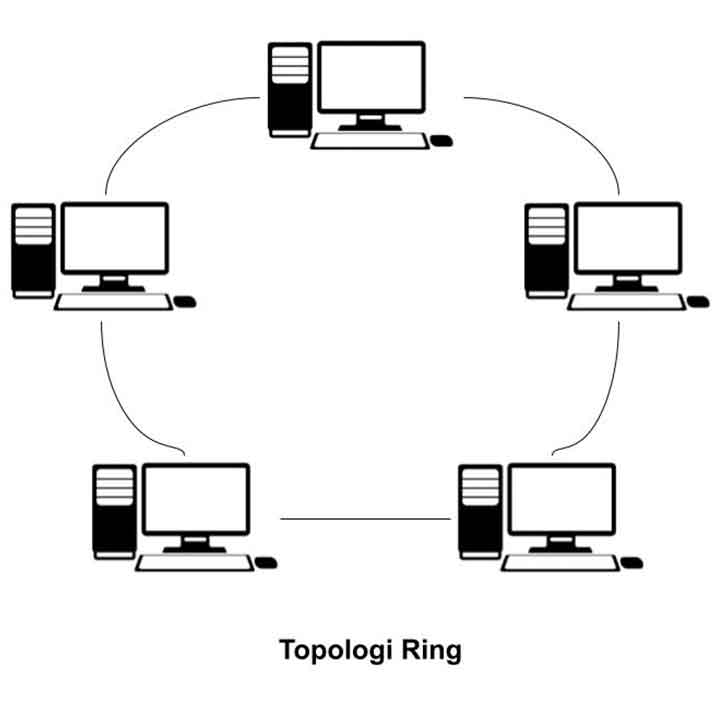
A ring topology is a topology that is formed when all devices are connected, so that it resembles a ring or circle pattern.
So, each workstation will receive information from one device to another device.
The advantage of a ring topology is that there will be no collisions or collisions between data.
Meanwhile, the disadvantage of this topology is that if one node experiences a problem, the entire network will experience problems.
3. Star (star)
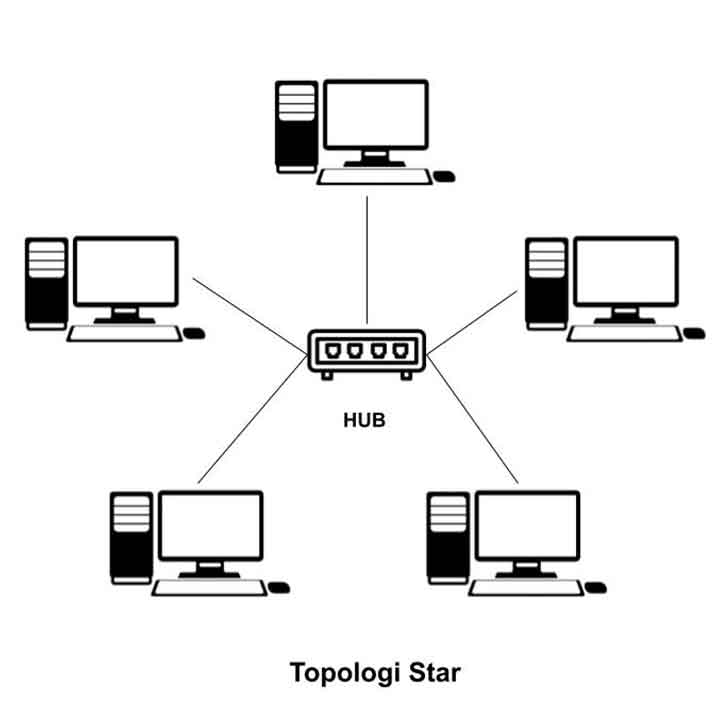
Star topology is a topology where each workstation has a path that is directly connected via a server or hub.
The advantage of this topology is that if one workstation experiences interference, not all networks will experience the same thing.
This is because each workstation has its own path or cable. The disadvantage of star topology is that it requires large costs, because it requires a lot of cable resources.
4. Tree (pohon)
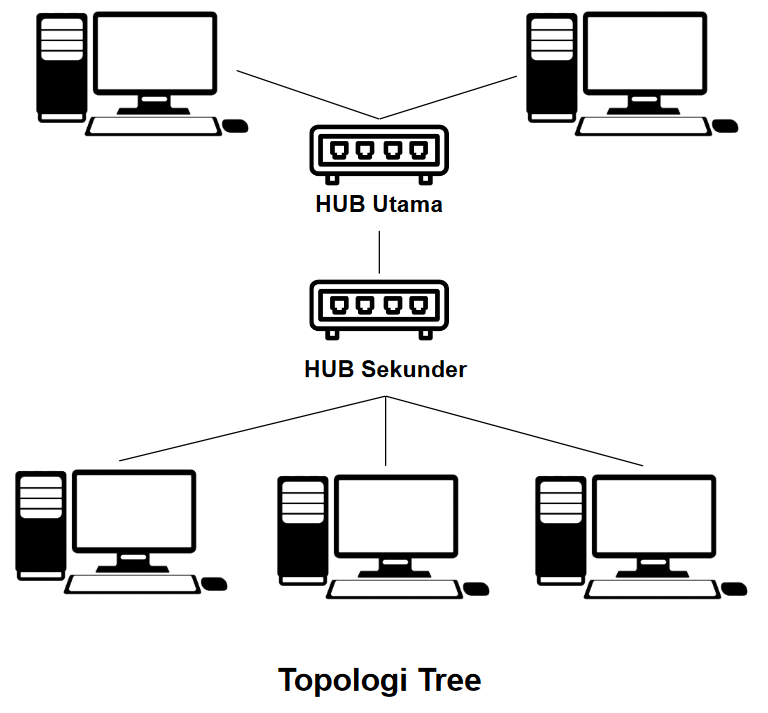
Tree topology is a combination of star and bus topology. This network topology resembles the shape of a tree root, which can be said to be the only hub device that is connected directly to the tree bus.
And each hub functions as the root of the tree.
The advantages and disadvantages of tree topology are the same as bus and star topologies. However, using this tree network (hybrid) supports better network expansion.
5. Mesh
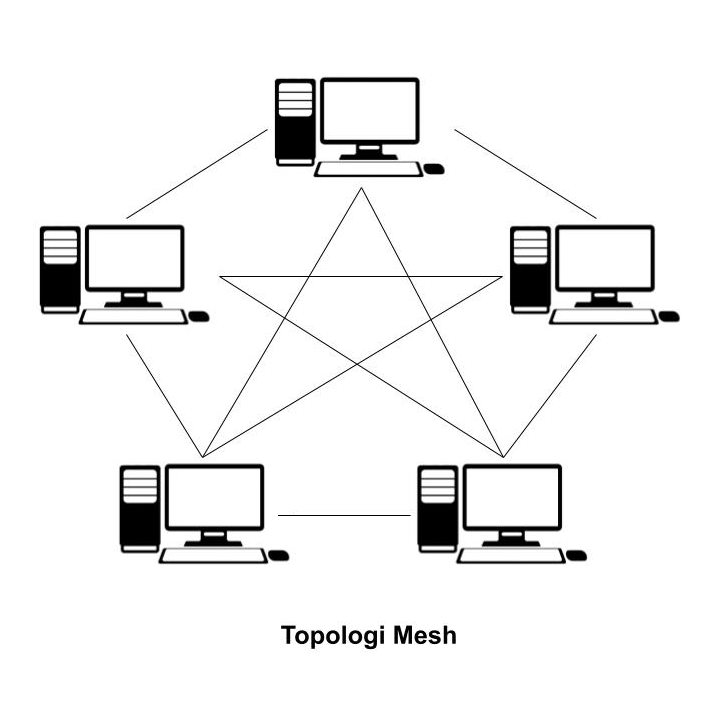
Mesh topology is often used when there is a condition where there is no absolute disconnection of communication links between nodes in a computer network.
Devices will be connected directly as long as they are still on the same network.
The advantages of a mesh topology are faster communication between computers and more guaranteed security.
The disadvantage of mesh topology is that it requires greater costs in providing cables.
Types of Computer Network Devices
You already know about the meaning of computer networks, their types, and computer network topology and now see a review of various computer network devices.
Now, many kinds of computer network devices have been developed to help and optimize network system performance.
The following are several types of devices that you often encounter and use.
1. Server
Servers function as a place or medium for storing information, as well as managing computer networks.
The server has higher specifications than the client. Because the purpose of creating a server is to serve client computers.
2. NIC (Network Interface Card)
NIC can also be called a LAN Card Expansion Board which is used so that computers can connect to a network.
Ethernet is divided into four types, namely ethernet (10 Mbit/sec), fast ethernet (100 Mbit/sec), gigabit ethernet (1000 Mbit/sec), and tengig (10,000 Mbit/sec).
3. Network cable
Cables are a medium for connecting one device to another device. There are several types of cables for creating network channels.
Among them are coaxial cable, fiber optic and twisted pair.
4. Hub dan Switch
A switch is a computer network device that functions to connect several computers.
Physically, the shape of a switch is the same as a hub, but if you look at it from a logical perspective, a switch is the same as a bridge.
Switches have two types, namely unmanaged switches which are the cheapest type. And managed switches are the most expensive type.
5. Router
A router is a network device that functions to connect a LAN network into a WAN network, as well as managing data traffic in it.
Routers can determine the best path, because they have a routing table to record all addresses in the network.
6. Bridge
A bridge is a device used to forward traffic between network segments based on information on a data link.
Bridges also have the function of dividing a large network into several small networks.
7. Modem
A modem is a device used to connect computer devices with an internet service provider or also called an Internet Service Provider (ISP).
8. Repeater
A repeater is a device that functions to strengthen and regenerate the network and incoming signals.
Repeaters attempt to maintain the integrity of the network signal. The weakness of the repeater itself is that it cannot filter traffic on the network.
9. Wireless card
A wireless card is a device that must be used if you want to connect to a wireless network.
On average, the latest types of computers already use devices that support wireless cards. However, you can also add it yourself to your computer.
Benefits of Computer Networks
The following are some of the benefits of computer networks in everyday life.
1. To share documents
The first benefit is that it is used as a medium for sharing documents that you have with other computer devices using the internet network.
You can share documents using a data cable or wirelessly.
2. To maintain and manage data security
Data will be better if it is stored more centrally. Apart from that, the network is also useful for making it easier for administrators to manage important company data.
By utilizing a shared server, each employee is able to search for data quickly and efficiently.
3. Make it easier to communicate
Computer networks also make it very easy to communicate between teams and with other people from different geographical locations quickly and accurately.
By communicating appropriately, you can help overcome any problems that may occur within the company .
4. Convey information quickly
With the help of Jarkom, the process of conveying information becomes faster without time and place limitations.
You can read any information from various corners of the world .
5. Helps human activities
And the final benefit of computer networks is that it helps every human activity to be more effective and efficient.
With a good network, every activity both inside the office and outside the office can be connected well.
Negative impact
Apart from the benefits resulting from the computer network itself, there are also negative impacts from several things which we will explain below.
1. Network Fees
To be able to use the network well, you also need to prepare every need, starting from software, hardware, as well as investment in network design planning.
2. Management and Maintenance Costs
Network management and maintenance also needs to be paid regular attention by a professional IT team.
Thus, reducing the possibility of undesirable things occurring such as damage to software or hardware.
3. Unwanted Sharing Activities
The third negative impact, with network traffic that is not well controlled, increases the risk of documents (files) being shared being infected with viruses or spam on the computer.
4. Network Security Threats (Network Security)
With the ease of the communication process which can be carried out anywhere and at any time in real time, of course it also increases the risk of other problems arising.
For example, the spread of illegal content, data theft, and other information security problems.
Yes, those are the types and definitions of computer networks.
By reading the review above, we hope it will be useful and broaden your insight!
